Darrell Brooks trial: Defendant calls 9 witnesses, outbursts continue

Brooks trial: Testimony, outbursts highlight Week 3's conclusion
Charged in the Waukesha Christmas Parade Attack, Darrell Brooks brought more witnesses for his defense to the stand in his trial on Friday, Oct. 21. The defendant's outbursts continued, and he was removed from the main courtroom multiple times.
WAUKESHA, Wis. - Darrell Brooks brought nine more witnesses for his defense to the stand in his trial on Friday, Oct. 21. Brooks is charged in the November 2021 Waukesha Christmas parade attack.
Early in day, there was talk that all testimony could be wrapped up by the end of Friday. However, Brooks himself said: "That's not gonna happen." By day's end, the judge said everyone who had been subpoenaed to testify had done so – but Brooks himself still has the right to testify.
Paperwork problems
As soon as court went into session on Friday, Brooks immediately asked the court for paperwork he said he was missing. Brooks said he would not call any witnesses until he had that paperwork in hand, but Judge Jennifer Dorow said it was Brooks' responsibility to have what he needed for his own defense.
After bringing the jury into the courtroom, Brooks continued to press the court for information. Eventually, the judge sent the jury out of the courtroom once again.
Brooks made a request of the court to subpoena his mother to be a witness for his defense. Dorow said that paperwork will need to be filled out and submitted in a timely manner.

Darrell Brooks trial: Friday fireworks to start the court proceedings
The court proceedings in the Darrell Brooks trial began with fireworks between Brooks and the judge.
Oct. 21 testimony, interruptions
Douglas Kolar, attended parade with daughter
First to take the witness stand on Friday for the defense was Douglas Kolar. He attended the Waukesha Christmas Parade with his daughter, who was marching in it. Neither Kolar nor his daughter were hurt in the parade attack.
Kolar testified about what he saw involving a red vehicle.
"As we were approaching White Rock I noticed a vehicle coming through where the parade participants were going. It was a red vehicle. It was honking its horn," Kolar said. "Between two of the groups, it veered to the left. A police officer attempted to stop the vehicle – reached for the door handle. The vehicle started to speed off."
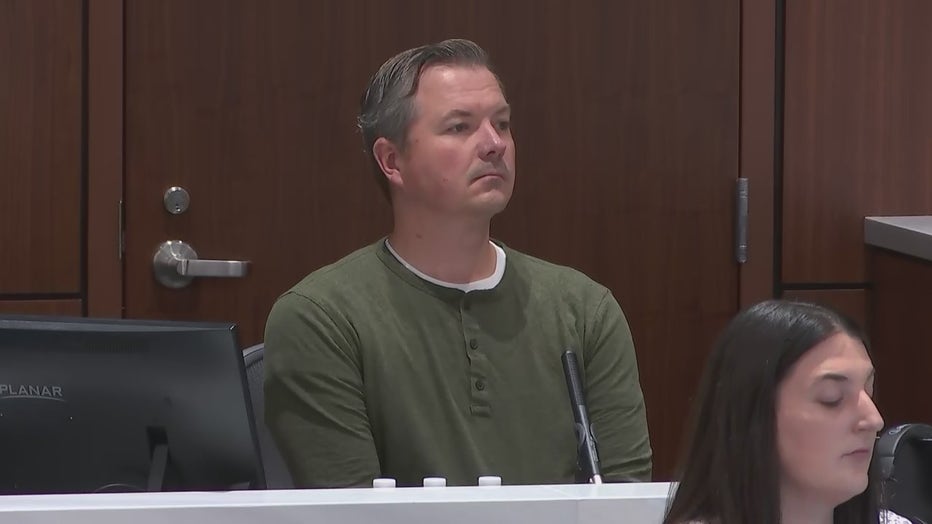
Douglas Kolar
Brooks asked Kolar if, as the vehicle sped off, it looked as if it were trying to avoid hitting people. Kolar answered: "At that point, yes."
Kolar testified that, after he saw the vehicle speed off, he grabbed his daughter and walked as fast as they could to their car. The witness described the vehicle as a "red SUV" – later adding that the rear windows were tinted.
Waukesha County District Attorney Sue Opper asked a couple of questions during cross-examination. One referred to the manner in which the red SUV was being driven. Kolar answered "yes" to whether it was driving erratically.
Opper also asked Kolar about a description of the person who was driving the vehicle. Kolar described the person has a Black male with dreadlocks and tattoos.
Steven Guth, Waukesha police detective
Waukesha Police Det. Steven Guth was next to take the stand. Guth previously testified for the state. Friday, he testified about making contact with Erika Patterson, Brooks' ex-girlfriend and mother to his child.
"(Patterson) stated she met with Brooks at Frame Park, she didn’t give him money, and he slapped her in the face," Guth said. "The next day she clarified it happened on (Nov. 21). He took her phone because she thought he was talking to other guys."
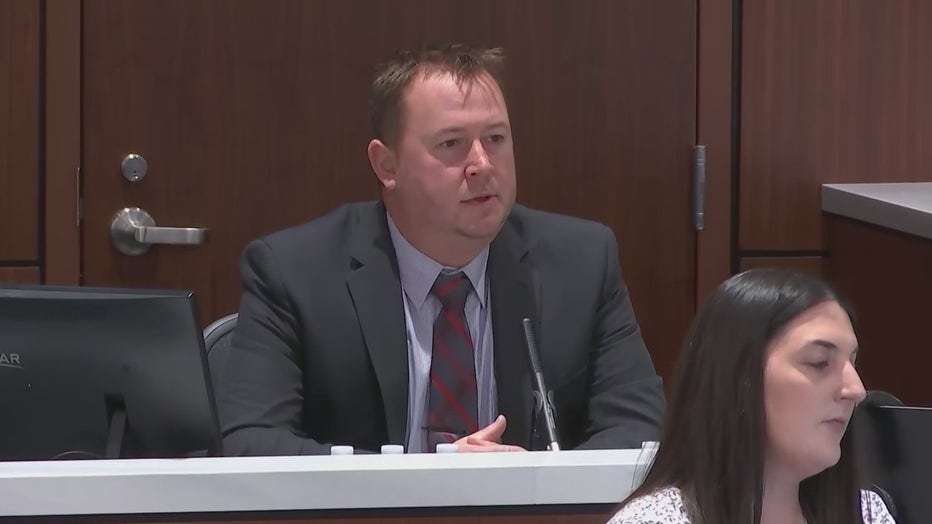
Steven Guth, Waukesha Police Detective
Brooks asked the detective about a fight near Frame park, and if he recalled recovering a knife:
Guth: "There was no knife."
Brooks: "Reported as a knife fight?"
Guth: "That's how it was originally reported and communicated to dispatch…She did not give me all the details of the incident initially."
Brooks: "Do you recall why?"
Guth: "I don't know why she didn't…She told me she was extremely afraid of you and that's why she didn't tell everything."
Brooks had no other topics for questioning Guth, and the state had no cross-examination.
Dispute over witness order
Around 9:45 a.m., after excusing the jury, the court asked Brooks to provide his next witness. It was expected to be Patterson, but the defendant appeared to be stalling.
Dorow told Brooks she could force him to call the next witness – or else the witness would be released from her subpoena. Brooks questioned if the judge had that authority, and she explained that she did.

Darrell Brooks trial: Defendant has an outburst about the order of his witnesses
Darrell Brooks trial: Defendant has an outburst about the order of his witnesses.
"I don't take that as a game. This is not a game for me. Nothing about this is a joke. It's disrespectful to me that you'd – your life is not on the line, mine is," Brooks said.
When the jury returned from break, Brooks again raised the "subject matter jurisdiction" claim that he has repeatedly brought up throughout the trial.
Erika Patterson, Brooks' ex-girlfriend
After a break, Brooks called Erika Patterson to the witness stand. Patterson had previously been called to testify by the state.
The line of questioning from Brooks centered on an incident that happened near Frame Park before the Waukesha Christmas Parade. Patterson testified she had argued with Brooks.

Erika Patterson
Brooks pressed Patterson, asking whether she was forthright with information when she spoke with Guth about the Frame Park incident:
- Patterson: "I just didn’t tell him everything right away."
- Brooks: "Why not?"
- Patterson: "I don’t know, Mr. Brooks."
Patterson continued to testify about how she knows Brooks, including for how long and where they met – topics that were also discussed during her testimony for the state.
When Brooks attempted to introduce new pictures into evidence. The court and prosecution raised objections. That set off another chain of exchanges between Dorow and Brooks, and the judge excused the jury.
Darrell Brooks trial: Defendant, judge exchange about the admittance of evidence
Darrell Brooks trial: The Defendant and Judge Jennifer Dorow had a vigorous exchange about the admittance of evidence Brooks wants in the trial.
"Stop it. You are a public servant. Your job is to be the umpire," Brooks said.
Brooks tried to introduce a letter as evidence, but the judge said relevancy needed to be determined. It was related to a dismissed charge for an incident that happened the day before the parade attack.
"I have a child with this woman. How would I not know her handwriting?" Brooks said regarding the evidence he sought to admit.
Opper questioned Brooks' motive for wanting to include the evidence. Dorow then decided shortly after 11 a.m. that the trial would be in recess for lunch for one hour.
After-lunch argument
When court returned to session after the lunch break around 12:10 p.m., Brooks was in the adjacent courtroom. Dorow explained why.
"Today has been a rough day, to say the least," Dorow said in reference to Brooks' challenges of the court and the court process. "In my almost 11 years on the bench, to say that this is the most challenging of my career would be an understatement.

Darrell Brooks trial: Judge Jennifer Dorow describes Brooks' behavior during Friday's proceedings
Darrell Brooks trial: Judge Jennifer Dorow describes Brooks' behavior during Friday's proceedings
The judge noted Brooks' "tone, demeanor, decorum" and stated his objections are noted and well-documented – describing them as an effort to "distract and delay."
"When there is a ruling Mr. Brooks disagrees with, he has a pattern now asking for verified law – debating the topic once again – or turn us away from that by bringing up another topic," the judge said. "He tries to divert things down a different path."
Dorow further described Brooks' behavior during the trial as "volatile." She added that his behavior on Friday, specifically, was "stubbornly defiant."

Darrell Brooks trial: Brooks argues with judge from adjacent courtroom
Darrell Brooks trial: Brooks argues with judge from adjacent courtroom
"It is this court’s opinion Mr. Brooks is blatantly pushing the limits of the court," the judge said.
The court went back on the record around 12:40 p.m. and Brooks, still in the adjacent courtroom, was allowed to speak. After a brief exchange about Patterson's testimony – which the judge called a "rehash" – there was another break to bring Brooks back into the main courtroom. Just before 1 p.m., though, Brooks was sent back to the adjacent courtroom as he refused to answer questions about his line of questioning for Patterson.
Once the jury was brought back in, Patterson stepped down. There was no cross-examination from the state.
Deanna Aldrich, Waukesha resident
Brooks called Deanna Aldrich to the stand. She lives on Maple Avenue in Waukesha and testified she heard a "large thumping noise" in her neighbor's yard. When she came out, Aldrich stated she saw an SUV that was "smashed to smithereens."
Aldrich testified she did not have her glasses on, so she could not clearly see the person who got out of the SUV. She was "running in and out" of her house to get her glasses.
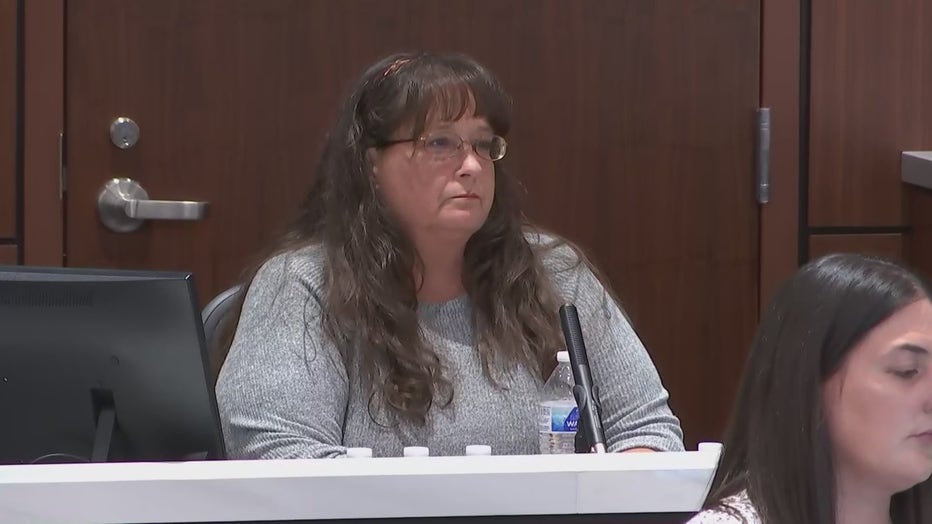
Deanna Aldrich
Brooks asked Aldrich if she recalled whether the SUV had any tinted windows; she said she did not. Aldrich further testified that she did not learn what the loud noises were before she saw the SUV.
Aldrich added that she was aware of the parade, but did not attend it. There was no cross-examination from the state.
Christopher Bertram, says he saw ‘smashed up red car’
Next to testify for Brooks was Christopher Bertram, who stated he saw a "smashed up red car" on the evening of the Waukesha Christmas Parade.
Bertram stated he did not see if the vehicle had any tinted windows, and did not recall a description of the driver. However, he testified he saw the driver reach down and grab something – possibly a gun.
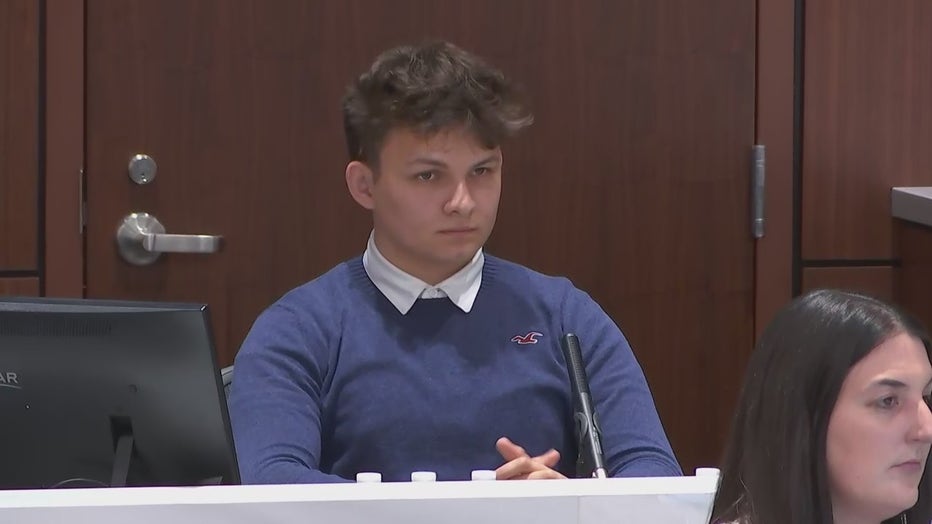
Christopher Bertram
Brooks asked Bertram if he recalled telling law enforcement about hearing a lot of gunshots.
"Yes, sounded like it came from downtown," Bertram said. "A full magazine."
The state did not cross-examine Bertram.
Brooks ‘stare down’
In the middle of afternoon testimony, after a witness was excused from the stand, Brooks asked to have an issue addressed. The jury was excused.
Brooks then proceeded to suggest to the court that the witnesses taking the stand were coached by the prosecution on their answers. He also wondered why the state was not cross-examining the defense's witnesses.
"All of a sudden, the state doesn't have questions – rush through the case. I see through it. I'm far from an idiot," Brooks said.

Darrell Brooks trial: Defendant raises legal issue, stares down judge after arguing his point
Darrell Brooks trial: Defendant raises legal issue, stares down judge after arguing his point
Moments later, Brooks slammed his hand on the table and began staring very intensely at Dorow.
"This man is having a stare down with me. Frankly, it makes me scared," the judge said.
Court was then put into recess.
Jason Hayes, attended Waukesha Christmas Parade
After arguments over who would be his next witness, Brooks called Jason Hayes to testify. Hayes said he went to the parade as a spectator with his daughter and was not injured in the attack.
Brooks asked Hayes if "anything unusual" caught his eye the day of the parade, Nov. 21, 2021. Hayes said a "red truck" came through near Main and White Rock. He said the vehicle "honked and swerved," but he did not know why.
Hayes further testified that it was a single "honk" and that he "saw it continue" through the parade. He described what he told police in an interview "a couple days after" the parade attack.
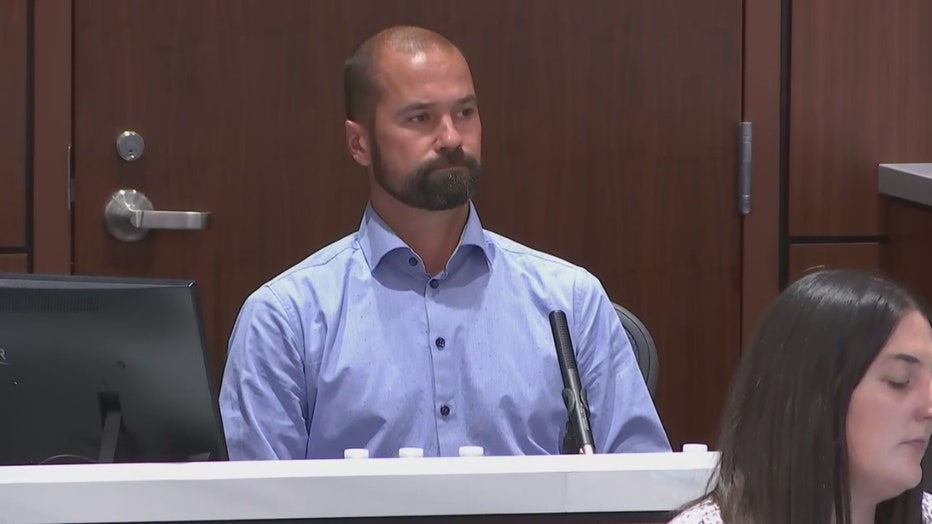
Jason Hayes
"In your opinion, (the SUV) wasn't trying to strike the kids?" Brooks asked.
"Yes," Hayes said. The witness added that he did not see the vehicle hit anyone.
Opper cross-examined Hayes, asking what he recalled about the incident – such as if the vehicle sped off and if he saw police run after it. Hayes said he thought he remembered seeing an officer run after the vehicle and that the driver had a "dark complexion."
On redirect, Brooks asked Hayes what he would consider a dark complexion. Hayes just repeated the description, Brooks said it was "kind of hard" to describe and asked Hayes if he noticed the driver's clothing or hair. Hayes said no, and was excused.
Abel Lazcano, attended Waukesha Christmas Parade
The defendant called Abel Lazcano to testify. Lazcano attended the parade with his wife and daughter and said he came across the red SUV parked on Maple.
Brooks questioned Lazcano about what he saw of the incident. Lazcano identified the driver of the SUV as Brooks and said he flagged down an officer at the scene. He did not recall if the SUV had tinted windows.
"Do you remember saying you saw three Black males fleeing the vehicle?" Brooks asked.
"I do not," Lazcano answered.
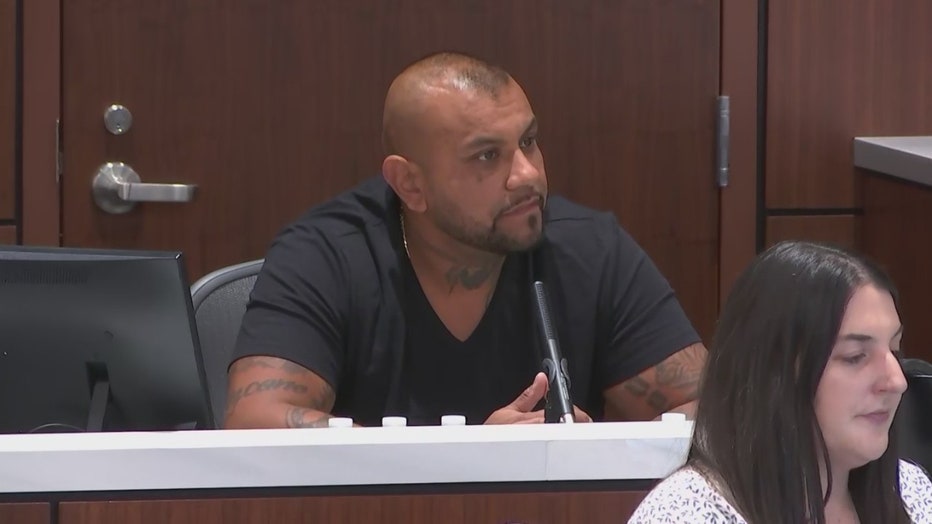
Abel Lazcano
Questioning continued about what Lazcano said he saw, such as what people were wearing and where they were. Multiple times, Brooks asked if the witness remembered specific details about what he told police.
"I don't remember," said Lazcano. "I can't tell you, that was too long ago."
Brooks asked Lazcano how he found the vehicle on Maple. Lazcano said he was walking with his family back to their car, trying to get them to safety, when he saw it. He added that he found it parked, apparently having reversed into the driveway of a home. He said he saw a few people standing around the vehicle.
FREE DOWNLOAD: Get breaking news alerts in the FOX6 News app for iOS or Android.
Upon cross-examination, Opper asked Lazcano if he saw the SUV hit people in the parade.
"It just kept swerving, plowing everybody out of the way until it got to the front of us and hit somebody and did like a cartwheel in the air," said Lazcano.

FOX6 News interview with defense witness, Abel Lazcano
Darrell Brooks called Abel Lazcano to testify Friday. Lazcano attended the parade with his wife and daughter and said he came across the red SUV parked on Maple.
Opper also asked about how Lazcano came upon the SUV. He was shown an exhibit and identified the vehicle and the area it was in, pointing out the people who were standing around it. Dorow sustained an objection from Brooks for speculation.
Again, for the court, Lazcano identified Brooks as the driver. He described people running and said he'd never previously spoke to Opper.
Upon redirect, Brooks asked Lazcano more questions about the driver he saw. Lazcano said he saw the driver for a "couple seconds" and described the driver as a Black man with a scruffy beard. He also, again, described seeing people standing around the parked SUV.
Kathleen Yourell, kids were in the parade
Brooks called Kathleen Yourell to the stand. Yourell testified that she dropped off her kids, who were participating in the parade, at the corner of Main and East.
Upon questioning, Yourell said she did not recall if there were barricades set up. She said she left her kids and was leaving to get to the end of the parade, so she could pick them up. She described what she saw.
"At this time a car was beeping and weaving through around a slight curve White Rock has and then continued on," said Yourell. "Started to move forward, then straight across, thinking it would leave the parade route. If you're turning right, you're going right into the parade – and it went right."
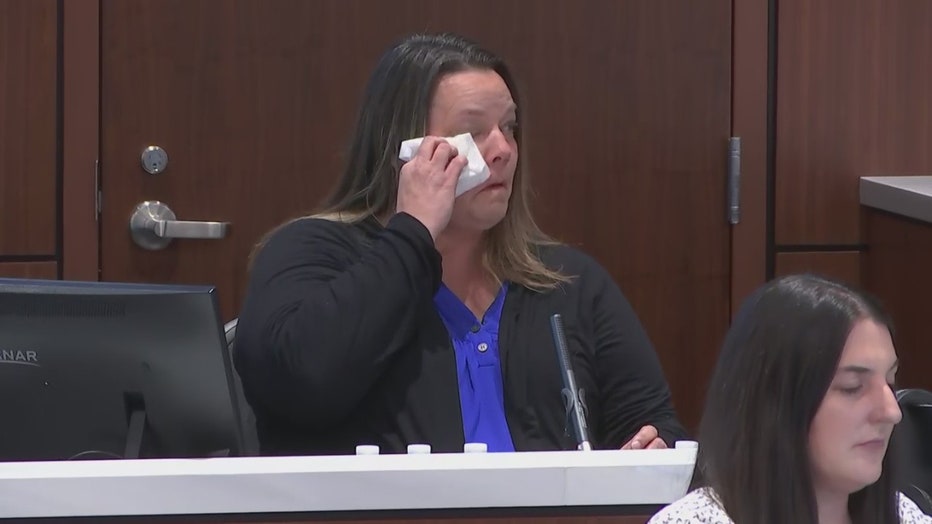
Kathleen Yourell
Yourell said she did not see the driver, did not recall seeing anyone get hit and did not recall if the SUV had tinted windows. She said the vehicle was speeding and was close enough that it "could've easily clipped" her or the people she was with. She was not injured.
Assistant District Attorney Zachary Wittchow cross-examined Yourell. She said she was in the crosswalk and that it was clear to her that there was a parade route. She agreed that it was clear that the driver should not have driven into the route.
Yourell became emotional on the stand as Wittchow asked about her four kids, who were all in the parade. She said two of her kids were marching with the Xtreme Dance Team group. She did not see her other two kids for days, she testified, because she was staying with her two injured kids in the hospital for days.
Katrice Babiasz, law enforcement dispatch supervisor
Katrice Babiasz, a law enforcement dispatch supervisor who was at the parade, was the ninth and final witness called to testify Friday. She testified that she saw a red SUV, and that it almost hit her daughter.
"The vehicle, the driver, was honking the horn," she said.
Babiasz described "gesturing" from the driver. Brooks asked for clarification, and she said she took the gestures as the driver trying to tell people to get out of the way. She said she "looked the driver right in the eyes" and the driver "looked, like, through me." The witness described the driver as having hair "like dreads" and facial hair. She also described seeing barriers positioned along the route – but didn't see if anyone was hit.
"I lost sight of the SUV once it went into a bunch of people," said Babiasz.
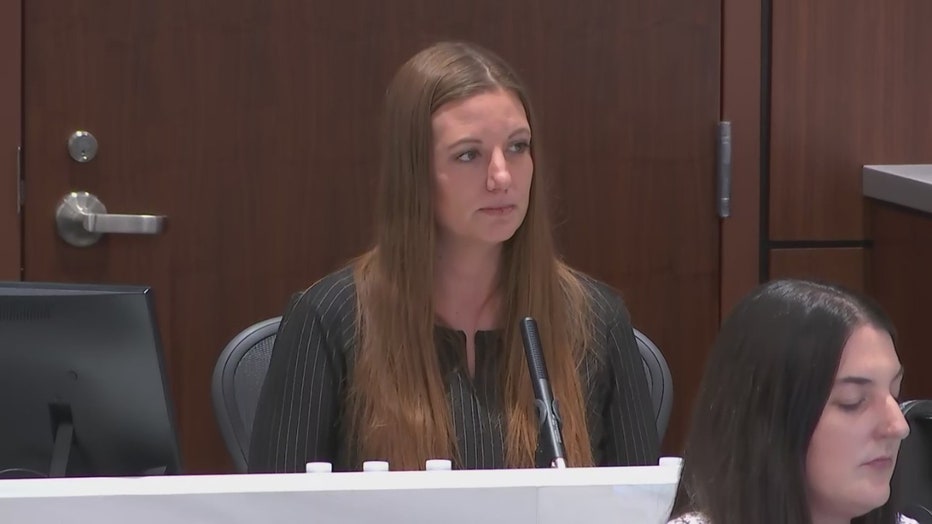
Katrice Babiasz
Babiasz testified she left the parade after seeing the SUV. She said she was injured – but later specified that she was not physically injured. She said she "didn't want to talk to anyone about the traumatic incident" and did not file any claims.
Brooks asked Babiasz if she thought the SUV was trying to hit anyone.
"Yes," said Babiasz. "I saw that an officer had to get out of the way. He was attempting to stop Mr. Brooks from driving through the parade, and he was – at the last minute – jumped out of the way of the vehicle, otherwise he would've been struck."
The defendant then began a line of questioning about Babiasz's subpoena to testify. Dorow explained the situation:
Dorow: "Mr. Brooks, she's here under your subpoena."
Brooks: "What? This is mind-boggling."
Dorow: "I'm asking you to move on."
Brooks: "You're all just ridiculous, man."
Throughout the exchange with the judge, Brooks tried to continue questioning Babiasz – implying the witness was coached on her answers. Brooks added "this is ridiculous" as the judge tried to move him along.
The state cross-examined Babiasz, who said she and her kids were in the roadway when the SUV drove through. She said they saw Santa, which marks the end of the parade. Brooks' interruptions continued during cross-examination – his objections overruled.
"Of course, as usual, it's always overruled," he said.
Babiasz further described seeing police try to stop the SUV near Main and White Rock. She added that other people tried to stop it, too. She said it appeared to speed up and that it "drove side-to-side" as it went through the parade.
Upon redirect, Brooks asked Babiasz to confirm that she saw multiple officers try to stop the SUV. She said she did. Brooks then called Babiasz's recollection into question:
Brooks: "There may be some details you don't recall, so would it be fair to say you don't quite recall the path of the vehicle?"
Babiasz: "No, that is not correct."
Brooks: "What other details do you not recall?"
Brooks: "Seems almost as if you're recalling what you want to recall and purposely not."
Dorow sustained the state's objection that Brooks was badgering the witness. She ordered Brooks to not badger or intimidate the witness, explaining that his facial expressions were included in that direction.
"You can't be serious now? What have I done to intimidate the witness?" said Brooks, adding after Dorow's response. "How are you even a judge?"
Testimony then ended for the day.
'No integrity’ outbursts
As Dorow tried to read jury instructions, Brooks continued muttering about how she was "even a judge." He accused her of not telling the jury the truth and said she had "no integrity."
The judge asked if Brooks filled out a subpoena for his mother, Dawn Woods, to testify.
"If I want her to be here, she's going to be here," he said. "All I gotta say is ‘come.' She's gonna come, that simple."
Brooks then began yelling at Dorow, saying he just wants the trial to be over: "I'm tired of being in a courtroom that has no integrity." He was then moved to another courtroom.

Darrell Brooks trial: Defendant's outburst at the end of Friday testimony
Darrell Brooks trial: Defendant's outburst at the end of Friday testimony
"He is yelling at me," Dorow said.
"Don't try to address me like that, like we're cool," said Brooks.
With Brooks out of the courtroom, Dorow continued to explain her rulings. She said the defendant was "disparaging the court" and "standing for hours even though I directed him to sit down."
"It was very apparent to this court and anyone watching that Mr. Brooks was not pleased with the witness' answers. He’d roll eyes, make other gestures – it was apparent to this court he did not like her testimony," Dorow said of her badgering-the-witness ruling.
What's next?
The judge said the court got through all the witnesses that were subpoenaed to testify for Brooks' defense. Dorow said Brooks gave permission to call his mother as a witness, but she had not been subpoenaed.
The only other witnesses Dorow said she could identify for testimony would be Brooks himself. She said she wasn't looking for an answer Friday, but that he could "contemplate over the weekend." He has the right to testify, the judge explained, and the state has the right to question him.
"It is his decision and his decision alone on whether to testify," Dorow said.
If Brooks does not answer whether he would like to testify, the judge said, it will be interpreted by the court as a "no" – meaning he chose not to testify – given "how the trial has progressed."

Darrell Brooks is 'acting like a child,' expert says
Darrell Brooks brought more witnesses for his defense to the stand in his trial on Friday, Oct. 21. Brooks is charged in the November 2021 Waukesha Christmas parade attack.
The jury cannot use Brooks' decision on whether to testify against him, Dorow said. Prosecutors said they do not plan to have rebuttal witnesses.
"The state should be prepared to start closing arguments," said Dorow.
The judge anticipates a "lengthy" jury instruction conference and plans to start instructing the jury Tuesday; there are more than 100 pages of instructions.
Before court ended, Dorow asked Brooks if he had anything to address.
"Why haven't I been given the chance to offer my filings into evidence. I would like every single filing I place into evidence. Every last one of them," said Brooks.
"You all need to cut it out, seriously. Stop it. Seems like all you want to do is gang up, be biased, be prejudiced and gang up.
Brooks also accused the court of making "false records" and violating his First and Sixth Amendment rights.
Court will resume Monday morning, Oct. 24 at 8:30 a.m.
Christmas parade attack
Prosecutors say Brooks drove a red SUV through the parade route on Nov. 21, 2021, killing six and injuring more than 60 others.
On Nov. 21, 2021, according to prosecutors, Brooks met up with his ex-girlfriend in Frame Park, the same woman he is accused of running over with his red SUV earlier in November 2021. She told police they argued in his SUV before he started driving, and he "was driving around with one hand and striking her in the face with his other hand." She eventually got out and called her friends for help.
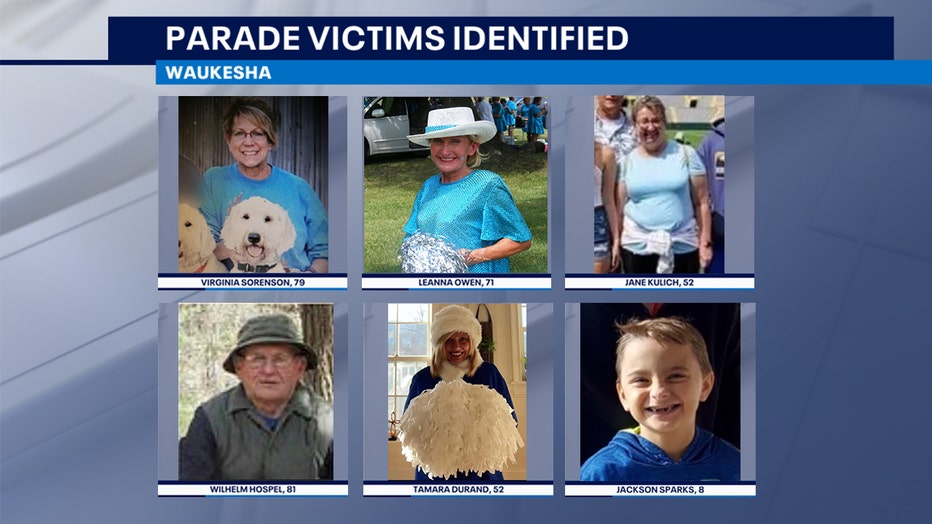
Waukesha parade attack victims identified
Soon after that, according to prosecutors, Brooks drove that red SUV through the parade route, killing Jackson Sparks, 8, Virginia Sorenson, 79, LeAnna Owen, 71, Tamara Durand, 52, Jane Kulich, 52 and Wilhelm Hospel, 81. More than 60 others were hurt.

